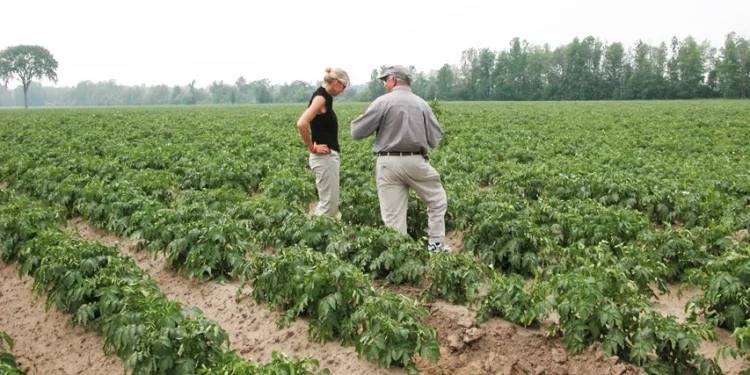Author: Dr. Eugenia Banks, Potato Specialist with the Ontario Potato Board. Article reviewed by Dr. Jiwan Palta.
Published here with permission.
Dr Jiwan Palta, a professor at the University of Wisconsin, is a recognized world expert on Calcium nutrition. He is a key speaker at many potato conferences, and we are fortunate that over the years, he has given 4 outstanding presentations at the Ontario Potato Conference.
Jiwan has made important contributions to clarify the role of calcium in potato production. Four of these are:
- Calcium in the tuber is absorbed from the soil in the hill by the tiny roots on tubers and stolons from the surrounding soil.
- Heat stress induces potato plants to close the stomata and shutdown until temperatures go down. Dr. Palta reported that potato plant will function normally under heat stress at specific levels of Ca2+ in the root zone. The Ca2+ level required for growth under heat stress exceeds that required for growth under normal temperatures.
- He has provided strong evidence that the ability of high Ca2+ levels to mitigate heat stress is by maintaining cell functions including stomatal opening and closing and cell enlargement at temperatures above 28C.
- Supplemental applications of Ca reduce heat stress and its consequent physiological problems such as heat necrosis, hollow heart, internal brown spot.
Supplemental applications of calcium to combat heat stress
According to Dr. Palta, timely calcium fertilizer applications directed to tuber development can help address heat and drought stress conditions.
Irrigated fields
In irrigated fields, he recommends liquid calcium fertilizers through the irrigation water during the bulking period. The recommended rate is for a total of 100 to 150 lbs of actual Ca/acre, which is split into three or four applications every two or three weeks, starting at the tuber initiation stage. Some of the formulations such as calcium nitrate contain nitrogen (N), therefore the N application needs to be adjusted to get the desired total N for the season.
Although initially there were some concerns that applying N later in the season would hurt tuber development, his research has shown that it does not. It is better for the plant and the environment to use split applications under irrigation, rather than applying all the N at hilling in mid-June, which can be washed into the groundwater by heavy rains.
Dryland
For dryland production, one option is to apply calcium at the last hilling time, mixing the product into the soil.
In sandy soils, because of the potential for leaching, it may be better to use less soluble products such as gypsum.
In heavier soils, soluble products such as granular calcium nitrate can be incorporated into the hill.

Dr. Palta: “Growers can also consider applying liquid formulations similar to how fungicides are applied and sprayed on the plant.
“If the application is tied together with a rain, then the rain will wash the calcium from the foliage to the top of the hill and down to the tuber. One consideration is to be careful putting a salt on the plant that can burn if not washed away by rain, however, using a dilute form and in adequate concentrations is useful and can be particularly important during heat stress periods while the tuber is developing.”
Overall benefits
Overall, the benefits of proper and timely calcium fertilizer applications include:
- Improved quality and yields
- Reduction in storage rot
- Reduced internal defects such as hollow heart, brown spots, black spot bruise








